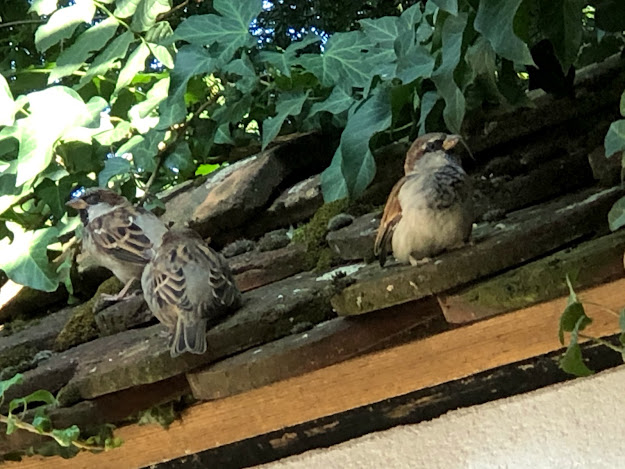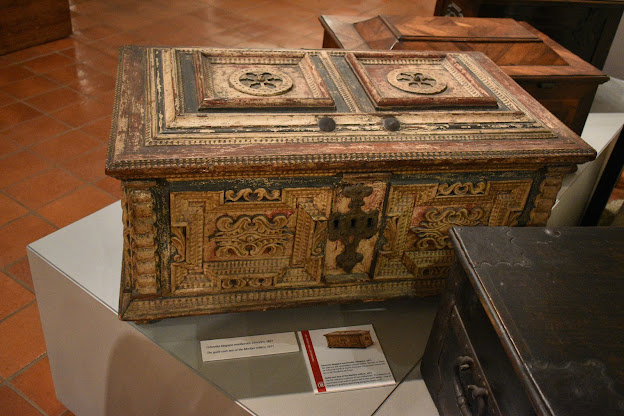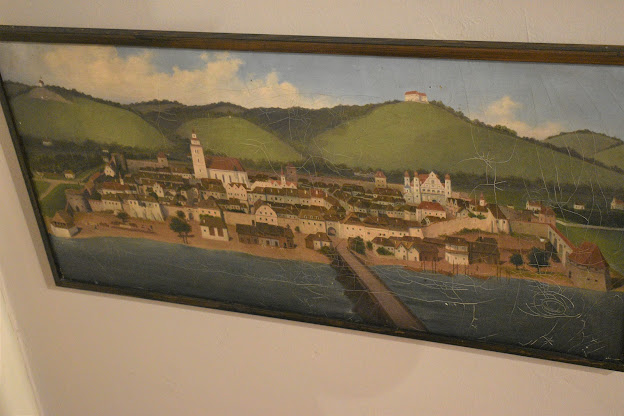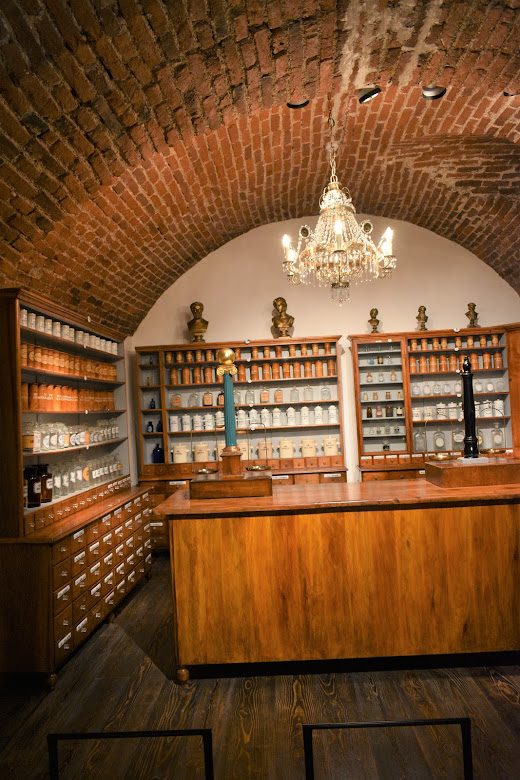We've been in town for long enough that we've walked past the castle several times. We noticed that it has a museum inside, so we decided to take an hour and go see what it has. It turns out the city government has collected most of the significant museums from around Maribor and combined them into an amazing display taking up most of the old castle.
The entrance on the South has amazing flagpoles that are wooden spires. Never seen the like before.
Inside, there is the ubiquitous gift shop, and a lot of display-previews of the various museums they've collected. Then there was a display of the artifacts they've found from digging up ruins dating from stone-age through medieval time periods. We were warned not to take flash photography, but that first floor was very dark, so I didn't take photos of ancient metals, buildings, gravesites, etc. It was very interesting stuff, though.
We walked through the central courtyard into the other side of the castle, and they had a display of tools used by wheel makers to make this ancient (and not very strong) medieval style of wagon wheel. (Notice that a spoke is missing from the higher wheel.) That style wheel broke easily and couldn't carry very much weight. They were fairly quickly replaced by spoke wheels which were still in use into the 20th century. I am amazed they still have examples of this old style of wheel available, even in museums.
They had a collection of old cash boxes. This one is dated 1756 and was the Stone Cutters' Guild cash box. You can see the ends of several other cash boxes - all ornate, with a raised section on the lid, and large lock-sets. The boxes are in immaculate condition - no doubt due to the loving care given to keeping them out of the hands of rough men.
This one is the cash box of the Miller's Guild and is dated 1671. The two carvings on the lid represent the grinding wheels used in a grain-grinding mill.
This is a wonderful collection of beehive fascia boards - a famously Slovenian folk art. They all have a notch on the bottom edge, which is where the bees go in and out of their hive. Representations of these boards are found in all the gift shops and tourist traps in Slovenia and even Croatia, but the ones they sell are usually the funny ones. For example, two men holding a cow by tail and horn while a milk-maid milks it. If you've worked with cattle you know the next scene after that, which is funny. Also lots of them where animals take the human parts and hunt the humans taking the animal parts. But, the boards on display here are largely representations of Catholic saints who might protect the bees. They are original and that's why some of them have beeswax/dirt over them.

The 2nd floor has an extensive collection of art, sculpture, uniforms, and ladies' dresses and accessories. This is the ubiquitous (in Croatia and Slovenia) St. George slaying the dragon. We've seen him in nearly every Catholic church we've visited here.
This is a painting of the old Marburg (as it was known back then) walled city. The castle is at the upper, right corner of the city and is bright white. At the bottom, the old bridge is shown. To the left of the bridge a bit and outside the wall, is the Old Vine House as it's known now, and our apartment is just back from that. In other words it is built into the wall of the city. That explains why the outside walls in our apartment are 30 inches thick! Really, truly.
This is a gold-plated sculptured painting of the adoration of the Magi. We think of the magi as "The three Wise Men" Scripture never gives a number of Magi who came, and this depicts nine already there and a long train with more Magi about to arrive. When I taught seminary, I loved to offer $20 to the first student who could find the scripture saying there were three. It inspired feverish searching, but my money was safe.
We took the elevator (thankfully - my knee was killing me) to the third floor and entered this long promenade. At the far end is the entrance into the ballroom from the old, royalty days, which was a theater in the 20th century, and is now used for events like weddings. This promenade is where people would come to cool off, meet in small groups, get drinks, etc. The flowers are lovely and the view is nice.
This is a high-wheeled bicycle in front of a photo of an old cycling club's membership. The photo has a cycle that is peddled while sitting - the precursor to a recumbent bike. There is another with a woman who appears to be set up to peddle with her hands, or maybe that's how she steers and it's also a recumbent?
I love clocks and this one is amazing. If I ever get a lathe again, and the inclination, I might attempt a copy of it. I probably won't do so much carving, though - I'm more into simplification. But wouldn't it be wonderful?
This is the grand entrance up to the ballroom. The royal couple would ascend on the red carpet, smiling, and waving at people they know or want to impress. Magnificent!
Next we went back down the elevator to the basement where they have the apothecary displays. The old-fashioned bottles, jars, and little drawers were a fixture of apothecary shops all over Europe and America. Asia did it a little different, but they also had tons of small drawers. The photo above is the left side of this display and below is the right side.
My bride was stunned at this display.
I was awed by the the space behind it. Here is a huge mortar and pestle, an infuser, a distiller, bags for vital chemicals like dried asofoedita weed (no medicinal value, but vital to make pills smell like medicine).
We did not get to the display of money, although they had about 50 gold coins from the 1100's on display in the little preview displays near the entrance. Those were hand-struck and a little rough, but they were in mint condition - no teeth marks that I could see. We'll have to go back to see the rest of the money.
After we left the museum, it was way past lunch time because we spent so much more time there than we'd planned. We had visitors during lunch and I decided to try out my new camera on close-up shots. These wasps are quite happy that restaurants have largely moved outdoors to prevent COVID-19 spreading. Amazingly, they are much more docile than American wasps. People swat at them and the wasps simply go away for a while. I haven't seen anybody stung by one.
A nice close-up of my friend. Cute, isn't she?
And since we are doing entomology today, I found this spider on the window sill back at the apartment.
These photos are OK, but what I really need for good close-ups is a better lens - a macro lens. One of the wasp photos is pretty good, but wasps are at the large end of the insect World, and this little spider is, too.
The next day, Wednesday, we drove down to Ljubljana where we had an appointment with an orthopedist for an evaluation of my knee. The news was good. We had a very friendly, intelligent young doctor who gave me an injection of corticosteroids. He said it should help for a half year, longer if I'm lucky and careful. He also said there are other injections we can try if that doesn't work.
1. Platelet enriched plasma. They take blood, spin it to separate the components, then add the platelets back into the plasma and inject it in the knee. It makes the tissue think it doesn't need to get inflamed in many patients.
2. An injection of stem cells. This also eliminates inflammation. He said the stem cells do nothing to repair the cartilage in the knee, though. Bummer!
3. Hydrocortisone, the oldy but goodie.
This makes me hopeful I can remain for our entire scheduled mission. If one injection doesn't work, I can try the next one and hopefully get through 18 more months. If the above fails, they will send me home for a knee replacement. I don't want that!






































